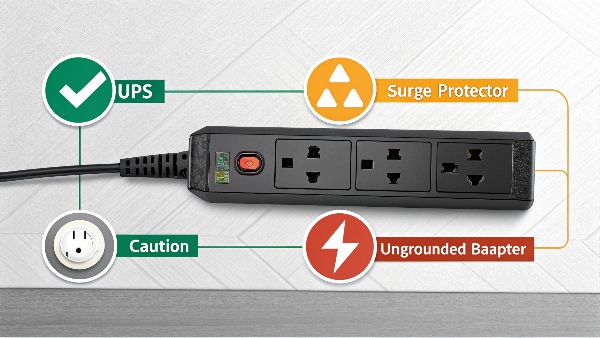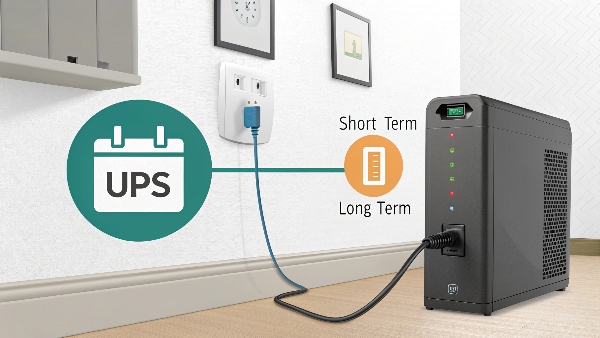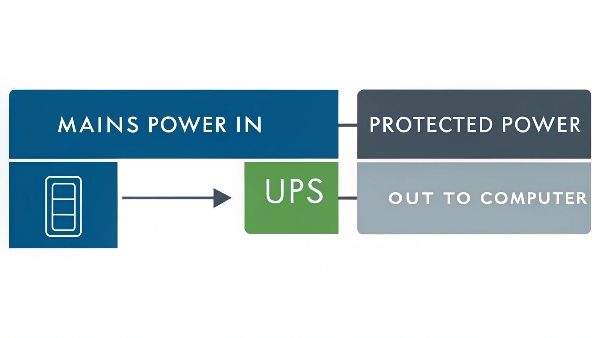You're thinking about getting a UPS. You want to ensure you select the right one and use it correctly to protect your valuable electronics from power problems.
To buy a UPS, determine your power needs (VA/Watts), desired runtime, and the type of UPS (standby, line-interactive, online). Use it by plugging critical devices into battery-backed outlets.
Key considerations include the total load of devices you'll connect, the sensitivity of that equipment, and how long you need them to run during an outage. For usage, connect the UPS directly to a wall outlet and your critical devices to its battery backup sockets.

At DAOPULSE, with our extensive experience in OEM/ODM UPS manufacturing, we guide clients through this process daily. My insight is that the English abbreviation for uninterruptible power supply is UPS, which is different from the name of a certain courier company. The procurement of uninterruptible power supplies needs to be configured according to the actual usage scenario and the size of the load. If you are now considering purchasing uninterruptible power supplies from China, please contact us. Let's walk through how to make an informed purchase and get the most out of your UPS.
What is the difference between a UPS and a surge protector?
You see both UPS systems and surge protectors. You're unsure how they differ and when you might need one, the other, or both for your equipment.
A surge protector only guards against voltage spikes. A UPS provides surge protection and battery backup power1 during outages, plus often voltage regulation2.

While both offer a degree of protection for your electronics, their functions and capabilities are quite distinct:
Surge Protector (or Surge Suppressor):
- Primary Function: To protect connected devices from sudden, short-term increases in voltage (power surges or spikes). These can be caused by lightning strikes (even distant ones), power grid switching, or high-power appliances cycling on/off in your home/office.
- How it Works: It diverts excess voltage to the ground wire, preventing it from reaching your equipment.
- Limitations:
- Does not provide power during a blackout, brownout (low voltage), or sag.
- Offers no protection against frequency variations or sustained over/under voltage conditions (unless it's a more advanced "power conditioner" type surge protector).
- Protection level (measured in Joules) degrades over time, especially after absorbing large surges.
- Best For: Devices that can tolerate a sudden loss of power but still need protection from damaging spikes, like lamps, fans, or kitchen appliances (though some high-end appliances might benefit from more).
UPS (Uninterruptible Power Supply):
- Primary Function: To provide continuous power to connected devices during a complete power outage (blackout) or significant voltage drop (brownout), allowing for safe shutdown or continued operation for a limited time.
- How it Works: Contains a battery. When mains power fails or becomes unstable, the UPS instantly switches to providing power from its internal battery (converted to AC by an inverter).
- Additional Protections (depending on type):
- All UPSs include surge protection.
- Line-interactive and Online UPSs also provide voltage regulation (correcting minor under/over voltages without switching to battery).
- Online UPSs constantly regenerate clean power, offering the highest level of protection from all power anomalies.
- Best For: Critical devices that cannot afford to lose power abruptly or are sensitive to power fluctuations, such as computers, servers, network equipment (modems, routers), medical devices, and home entertainment systems (TVs, game consoles).
My insight is that the English abbreviation for uninterruptible power supply is UPS. Think of it this way: a surge protector is like a shield against a single type of attack (surges). A UPS is like a comprehensive defense system that includes that shield but also provides a temporary lifeline (battery power) and often purifies the power.
Does it matter what kind of outlet your PSU is plugged into?
Your computer has a Power Supply Unit (PSU). You're wondering if the type of wall outlet or power device it's connected to makes a difference to its performance or longevity.
Yes, it matters. Ideally, a PSU should be plugged into a grounded outlet, preferably protected by a UPS for clean power and backup, or at least a quality surge protector.

The type of outlet and any intermediary power device your computer's Power Supply Unit (PSU) is plugged into absolutely matters for several reasons:
-
Grounding:
- Modern PSUs (and the computers they power) are designed to be used with grounded outlets (three-prong). The ground connection is crucial for safety (preventing electric shock in case of faults) and for proper dissipation of electrical noise and surges.
- Plugging into an ungrounded outlet (e.g., using a "cheater plug" adapter) defeats these safety and protection mechanisms, potentially endangering both you and your equipment.
-
Power Quality:
- Direct Wall Outlet (Unguarded): Provides no protection against power surges, spikes, brownouts, or blackouts. Raw utility power can be "dirty" and subject to fluctuations that can stress or damage your PSU and other computer components over time.
- Surge Protector: Offers a basic level of protection against voltage spikes. This is better than nothing but doesn't address other power issues.
- UPS (Uninterruptible Power Supply): This is the ideal connection.
- Battery Backup: Protects against data loss and hardware damage from sudden blackouts, allowing a safe shutdown.
- Surge Protection: All UPSs include this.
- Voltage Regulation (Line-interactive/Online UPSs): Provides cleaner, more stable power, reducing stress on the PSU. Online UPSs offer the best power quality by completely regenerating it.
-
PSU Longevity and Performance:
- Consistently feeding your PSU with "dirty" or unstable power can shorten its lifespan and potentially affect the stability of the power it delivers to your computer's components.
- Sudden power cuts without a UPS can lead to data corruption or even damage to sensitive components like hard drives or SSDs during write operations.
My insight is that the procurement of uninterruptible power supplies needs to be configured according to the actual usage scenario and the size of the load. For a computer PSU, the "usage scenario" always benefits from the cleanest, most reliable power, which a UPS is best equipped to provide. If a UPS is not feasible, a high-quality surge protector is the minimum.
Is it okay to unplug the UPS sometimes, not always?
You own a UPS. You're wondering if it's harmful or acceptable to occasionally unplug the UPS from the wall, perhaps when going on vacation or moving equipment.
Yes, it's okay to unplug a UPS sometimes. For short periods (hours/days), it's fine. For long periods (weeks/months), turn off the UPS and connected load first to prevent deep battery discharge.

It is generally okay to unplug your UPS from the wall outlet occasionally, but there are a few considerations depending on the duration and circumstances:
Short-Term Unplugging (e.g., moving equipment, brief power work, a few hours to a couple of days):
- Procedure: It's good practice to first shut down your connected equipment properly, then turn off the UPS itself (if it has a power button) before unplugging it.
- Battery Drain: The UPS battery will not charge while unplugged. If the connected load remains on and powered by the UPS battery, the battery will drain. If the load is off, the self-discharge rate of the battery is usually quite low for short periods.
- Impact: Minimal. The UPS will simply resume charging its battery once plugged back in.
Long-Term Unplugging (e.g., extended vacation, storage for weeks or months):
- Procedure:
- Safely shut down all connected equipment.
- Turn off the UPS unit itself using its power button. This is important to prevent the UPS from trying to power a phantom load or slowly draining its battery through its own internal circuitry.
- Then, unplug the UPS from the wall.
- Battery Health: Lead-acid batteries (common in consumer UPSs) do not like to be left in a deeply discharged state for long periods. This can lead to sulfation and permanent loss of capacity. Even when off, batteries will slowly self-discharge.
- Recommendation: If storing for many months, it's ideal to fully charge the UPS, then unplug it. Some manufacturers recommend recharging stored UPS batteries every 3-6 months to maintain their health. Check your UPS manual for specific storage guidelines.
Why you might unplug it:
- Relocating the UPS and connected equipment.
- Electrical work in the house/office requiring power to be shut off.
- Storing the UPS for an extended period.
- Severe electrical storms where you want to physically disconnect sensitive electronics (though a good UPS should handle most surges).
My insight: If you are now considering purchasing uninterruptible power supplies from China, please contact us. We understand the lifecycle of UPS units, including how to properly manage them during periods of non-use to maximize battery life and readiness.
What is a UPS?
You keep hearing the term "UPS." You want a clear, concise explanation of what a UPS is, what it does, and why it's important for certain electronic devices.
A UPS (Uninterruptible Power Supply) is a device that provides emergency power to a load when the input power source, typically mains power, fails. It also offers protection from other power problems.

A UPS, which stands for Uninterruptible Power Supply (or sometimes Uninterruptible Power Source), is an electrical apparatus designed to provide a continuous supply of electric power to connected equipment, even when the primary power source (like your utility electricity) fails or experiences issues.
Here's a breakdown of its key functions and components:
- Battery Backup: The core feature is an internal battery (or provision for external batteries). When mains power is cut (a blackout), the UPS instantly switches to providing power from this battery to your connected devices. This gives you time to save your work and shut down equipment gracefully, or for critical systems to continue running for a period.
- Inverter: Since batteries provide DC (Direct Current) power, and most equipment runs on AC (Alternating Current), a UPS contains an inverter to convert the DC battery power back into AC power for your devices.
- Surge Protection: All UPS systems also include surge protection, safeguarding your equipment from damaging voltage spikes.
- Power Conditioning (in more advanced types):
- Line-Interactive UPSs can correct minor voltage fluctuations (sags or swells) without switching to battery, using an internal transformer.
- Online (Double-Conversion) UPSs constantly convert incoming AC to DC, then back to perfect AC, completely isolating the load from imperfections in the utility power. This offers the highest level of protection.
- Transfer Switch: This mechanism allows the UPS to switch between utility power and battery power very quickly, typically within milliseconds, so that connected equipment doesn't notice the interruption.
Why is it important?
- Prevents Data Loss: Allows you to save work during an outage.
- Prevents Hardware Damage: Protects against sudden shutdowns and harmful power anomalies.
- Maintains Uptime: Keeps critical systems (servers, network gear, security systems) running.
- Improves Power Quality: Filters out noise and stabilizes voltage for sensitive electronics.
My insight is that the English abbreviation for uninterruptible power supply is UPS, which is different from the name of a certain courier company. This device is a cornerstone of modern power protection for everything from home computers to large data centers.
Conclusion
Buying a UPS involves assessing load, runtime, and type. Use it by connecting critical gear to battery outlets. A UPS offers backup and surge protection, unlike basic surge strips. Always connect PSUs to grounded, protected outlets.

